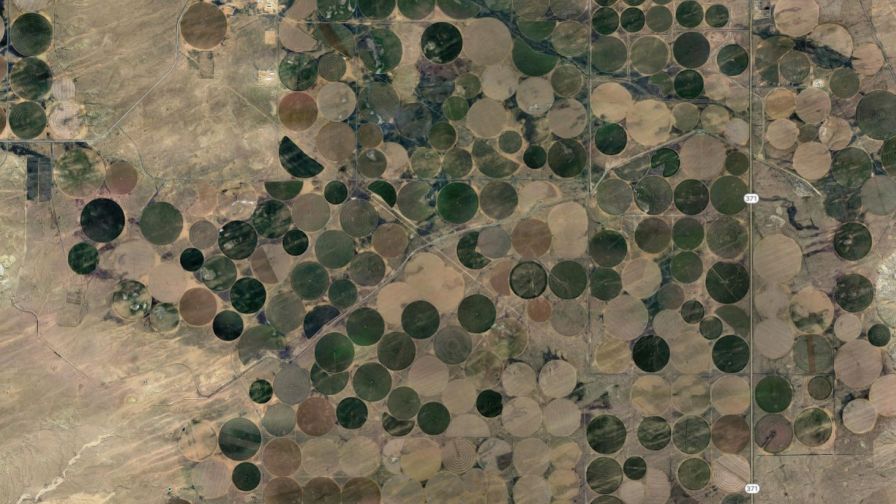Managing Pivot Irrigation in Drought Areas

A Google Earth view of a portion of Navajo Agricultural Products Industry’s growing fields.
Building up a moisture profile is essential to growing any crop; however even more so in areas with high heat and potential for extended periods of time with water issues. The moisture profile is imperative to crop health and ability to withstand some degrees of stress. Understanding plant physiology and how each crop and variety responds to moisture is also a key factor.
The goal for us is to maintain 80% to 85% deep moisture at all times with respect to how seed pieces and/or plants react in terms of quality and germination. We only want to be irrigating to refill moisture to a few inches to meet that 80% to 85% bank each time. We keep this in mind (we will alter this and get a little ahead in times of extreme heat degree days) to reduce chance of stress to plants.
Proper timing is crucial to plant health and development. Maintaining a deep moisture profile ensures that the plant roots have a reserve to pull from in the event of an induced drought period. The factors that impact any crop are evapotranspiration (ET), weather, soil, and poor water management.
The key to water management is all in the timing and keeping your crop ahead in times of need. Maintaining a proper moisture bank and utilizing natural timing of weather patterns allows you to easily maintain a moisture reserve thus allowing for reduced applications of water early in the season.
In the event of a severe drought that occurs during the season, the farmer needs to ask themselves:
- What is my current moisture profile?
(Use this model for each question below — in front of pivot, backside, behind)

- What is the deep moisture at …
- What is the surface moisture at …
- What is the moisture at root ball at …
- What is the moisture in the furrow at …
- How does my particular crop respond to stress?
- What can happen as a result of stress?
- How much stress can this crop take realistically?
- How does this impact yield/quality/ and health?
- How does this crop historically perform in harsh environments?
- At what age did the drought impact my crop?
- What age does my crop need the most water?
- What are my watering sources available to me:
- Based on planned return of water?
- Can I space out irrigations with remaining water sources?
- Can I leave water off based on crop age and timing?
- What is the projected timing of full return of irrigation ability?
These are basic questions that can help us as farmers evaluate your specific situation and likelihood of crop survival and overall success rate in helping the crop mitigate through a stressful time period such as drought conditions. Overall the important take away is that an instant evaluation has to occur in the event of a severe drought condition to determine viability of planted crops.
Stress is the key aspect to consider throughout any growing season from start to finish. This is the basis for the creation of and the maintaining of an adequate moisture profile that the plant needs in developing and mature stages.
Our job is to reduce plant stress and create an optimal environment in which a plant is allowed to become very vigorous, thus allowing it to naturally defend itself against pests and diseases. In the event of an induced drought; in-field applications for volunteer plants and insects must continue in forms that won’t create additional stress based on timing of return of watering ability or based on crop age and or issue.










